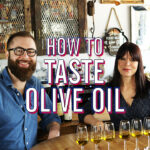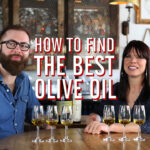 Good olive oil is not just delicious—it makes everything it touches extra delicious. It’s been the foundation of the Mediterranean diet for thousands of years and a symbol of prosperity and peace for the ancient Greeks, the biblical heroes, and way beyond. It’s absurdly healthy, full of monounsaturated fatty acids and antioxidants that have been shown to protect the heart and fight against diabetes, cancer, and even Alzheimer’s and osteoporosis.
Good olive oil is not just delicious—it makes everything it touches extra delicious. It’s been the foundation of the Mediterranean diet for thousands of years and a symbol of prosperity and peace for the ancient Greeks, the biblical heroes, and way beyond. It’s absurdly healthy, full of monounsaturated fatty acids and antioxidants that have been shown to protect the heart and fight against diabetes, cancer, and even Alzheimer’s and osteoporosis.
Yet buying olive oil can be daunting, even for its fans. Which so much fraud, how can we know if any one bottle is the real deal? Should we choose a bottle from California, or Europe, or elsewhere? Here’s where to start with the lovely and luscious lipid:
Freshness is Key
Olives are harvested in fall, and the best olive oil producers press and bottle their olive oil stat. That’s because time is an enemy of olive oil, causing it to slowly but surely oxidize and degrade. Nicholas Coleman, Oleologist (yes, that’s a thing…think sommelier of olive oil) and Co-Founder of Grove and Vine suggests that you enjoy your olive oil within three months after opening the bottle, and store it in a cool, dark environment away from the stove—light and heat speed up the oxidation process.
 Sense of Place
Sense of Place
Many regions in the world make excellent olive oil. “Regional characteristics make the world of olive oil interesting,” says Coleman. Tuscany, Andalucia, and Kalamata boast ancient, venerated olive oil traditions. California, Texas, Chile and Australia are much newer to the game and producing some gorgeous oils. Like in a great wine, terroir,or that ineffable sense of place shows up in the flavor, aroma and personality of olive oil.
When choosing a bottle, look for olives that come from a single country. According to Coleman, olives from a variety of different countries means “someone is mixing stuff from all over the world,” which is a bad sign. “It’s akin to a painter combining all colors—you end up with the same dark grey.” These oils are “devoid of their own unique characteristics and lack a taste of a place.”
Go for Extra Virgin
“Extra-virgin oil tastes good, smells good, looks good, is good for you, and brings out wonderful flavors you didn’t know existed in all of your favorite foods” says Steven Jenkins, olive oil expert and author of The Food Life.
Extra virgin and virgin olive oil are simply made by crushing olives. Extra virgin tastes better than virgin and scores higher in terms of its chemical composition—extra virgin has no more than 0.8 percent free oleic acid, and virgin contains up to 2 percent. It is also significantly richer in nutrients.
All other grades, like “pure” and “light” olive oil are refined—processed with heat and chemicals. (Kind of misleading because “pure” sounds pretty fancy, right? It’s not.)
Be Skeptical
Producing real-deal extra virgin olive oil and maintaining its quality through transport and the supply chain is incredibly difficult. Most ‘extra virgin’ oils on grocery store shelves do not deserve that status. They are past their prime, or they were never extra virgin to begin with. The only way to guarantee that your money is well spent is to taste discerningly, however…
Read the Label Like a Pro
 There are plenty of hints on the bottle. “You don’t go to a wine store and every label says red wine,” Coleman says. “Good oils have a harvest date on them because they are proud that they are fresh,” says Coleman. The label should also list what olive cultivar, or type of olive, the oil contains. “Just as in wine, certain olives have certain characteristics. If you see a Frantoio from Tuscany,you can make an educated guess that oil will be grassy, peppery, bitter, assertive and robust.”
There are plenty of hints on the bottle. “You don’t go to a wine store and every label says red wine,” Coleman says. “Good oils have a harvest date on them because they are proud that they are fresh,” says Coleman. The label should also list what olive cultivar, or type of olive, the oil contains. “Just as in wine, certain olives have certain characteristics. If you see a Frantoio from Tuscany,you can make an educated guess that oil will be grassy, peppery, bitter, assertive and robust.”
Another way to ensure your oil is of serious quality is to buy from a trusted source, like Grove and Vine, where Coleman personally sources fresh oils and ships them to members quarterly.
Say Yes to the Burn
Feel that peppery tingle in the back of your throat? That’s a really good thing. You’re tasting flavenoid polyphenols, the compounds in olive oil that contribute to its bitter flavor and huge health benefits. The burn is an indication of an EVOO’s antioxidant and anti-inflammatory value, and a sign you have some fine oil on your hands.
Think Beyond Salad Dressing
When Coleman visits olive oil loving countries to harvest and blend olives, people are not stingy with their oil. “The olive oil is the sauce,” he says. “They don’t drizzle; they pour it on.”
Great olive oil elevates everything it touches—salads, raw and grilled veggies, meat, seafood, soups, stews, pasta, and risotto. Dishes go from good to extraordinary with the addition of the magical elixir.
Now, watch Coleman and Wine4Food’s own Carole Mac talk about how to taste olive oil:
Hannah Howard is a writer and food expert who spent her formative years eating, drinking, serving, bartending, cooking on a hot line, flipping giant wheels of cheese, and managing restaurants. She is the author of the memoir Feast: True Love in and Out of the Kitchen. Hannah is a graduate of Columbia University and the Bennington Writing Seminars. She writes for SELF, New York Magazine, and Salon.com, and lives in New York City.
is a writer and food expert who spent her formative years eating, drinking, serving, bartending, cooking on a hot line, flipping giant wheels of cheese, and managing restaurants. She is the author of the memoir Feast: True Love in and Out of the Kitchen. Hannah is a graduate of Columbia University and the Bennington Writing Seminars. She writes for SELF, New York Magazine, and Salon.com, and lives in New York City.



